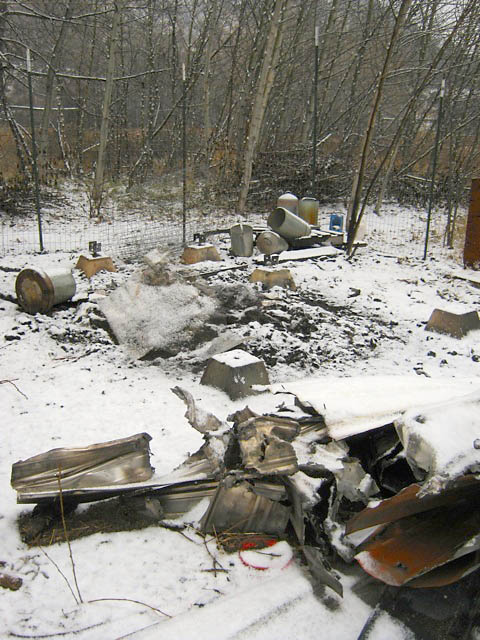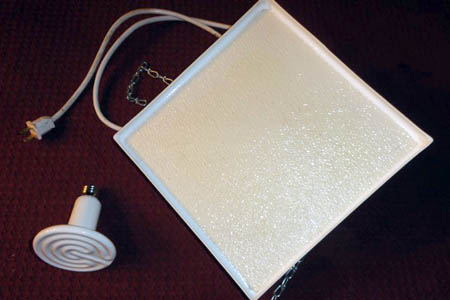|
Keeping the Coop
Heating safely
story and photos by Jane Gilbertsen
Dear Methow Chicken Keeper,
 The aftermath of a chicken coop fire in the Methow Valley. The Valley's latest coop fire hit Thanksgiving Day. Remarkably all six chickens that lived here survived and have found a foster home. That isn't always the case, nor is a coop fire always limited to the coop structure alone. In almost every fire a heat lamp is to blame. Firemen everywhere have been pretty busy since chicken keeping has become trendy. This doesn't have to be.
The first thing to consider is whether you really need a heat source and when. If all you need is a light source for the 14-15 hours needed to keep your hens producing eggs through the winter months do not use a heat lamp, use a light. If you have selected hardy breeds with ample feathering and small combs you might not even need supplemental heat on a regular basis. However, if you keep a rooster with a significant comb, heat will often be needed over the rooster's comb. Roosters cannot tuck their comb under their wing like a hen. Big combs frostbite easily and they will either heal a bit shorter or if extremely frozen, gangrene can set in and the rooster may die.
Consider the size of your coop, the size of your flock, whether they roost all smashed together or are able to roost high where it is a bit warmer. Small coops full of birds can produce significant heat (15 watts per bird) but they are too small for daytime use. Big coops are harder to heat, but they might be big enough for daytime use without the birds going stir-crazy if closed in on a very cold day. Birds need fresh air, the more the better, as they have fairly delicate respiratory systems and produce a ton of dust and moisture themselves. Unless extreme, cold is less harmful to their health than lack of ventilation. It takes some doing to provide good ventilation without drafts in the coop design but it can be done.
So what happens when a flock goes stir-crazy? They peck each other, the dominant de-feather the submissive, they draw blood. It is ugly. Once bad behavior starts it is impossible to break. It spreads like wildfire through the flock and persists. I have tried to cull (the euphemism for killing an undesireable chicken) bad actors and ended up decimating almost an entire flock. Farming is not for sissies.
Year round, birds need something to do everyday and space to do it in, again the more the better. Providing a winter roofed area for snow free space does the trick. Give them litter to scratch, loose dry dirt for bathing and a roost. If they can sunbathe part of the day they warm up and produce Vitamin D. They need it just like we do for physical and mental health.
When you do need heat, use an alternative to a glass heat lamp and consider a few other safety precautions.
Here are the basics:
-
 A ceramic bulb (L) that fits in a standard socket, and a safe "Sweeter Heater".
- Have the coop competently wired with a ground fault interrupter. If an extension cord is necessary, use the shortest and heaviest duty cord possible. Never staple or pinch the cord.
- NEVER USE A GLASS HEAT LAMP. EVER. Separate your heat source from your light source. They present 2 different issues entirely. LIghts belong on timers, heaters belong on thermo devices.
- Don't use incandescent bulbs either. They too present a risk. Use the totally safe LED bulbs. They are finally available locally. (Don't use compact fluorescents—they flicker at a rate disturbing to your birds.) Use timers so your birds will go in when dark and rest peacefully most of the night. Set the timer to go on in early morning and adjust as the days shorten and lengthen to stay at a minimum of 14-15 hours of light. Timers need to be used here from mid August to mid April for maximum egg production in a hen's youth.
- The least expensive alternative is a ceramic heat bulb (available as a reptile heater bulb). It screws in to a appropriately sized fixture just like a light bulb but it is far harder to break. You can generally use the inexpensive metal fixture usually used with a glass heat lamp. The ceramic bulb comes in sizes from 75 to 250 watts. You only need to heat where they roost to sleep, especially where the rooster sleeps. So size appropriately for the fixture and your needs. OR better yet, use an expensive but ultrasafe heater like the "Sweeter Heater". (Google "Sweeter Heater" to check it out.)
- Attach any heat device by two secure methods. I triangulate so if the ceramic heat lamp is hit in a chicken riot it cannot swing far. Never use the clamp provided. I like chains and carabiners for hanging lights. They don't burn and they don't break.
Both the ceramic bulbs and the Sweeter Heater work better than the heat lamp for chicks as well. Chicks do better if they have heat without light blasting in their faces 24/7. Wouldn't you?
That's it for now, be safe.
12/8/2013
see past stories in the archive >>
|
